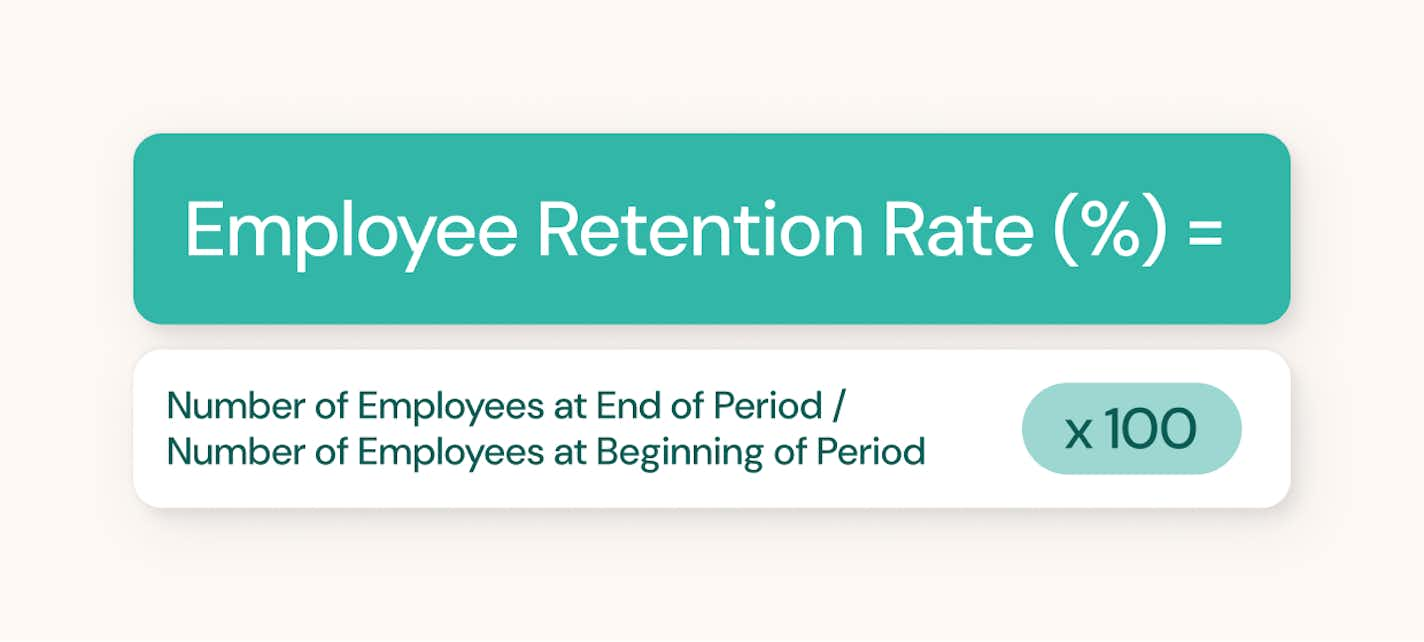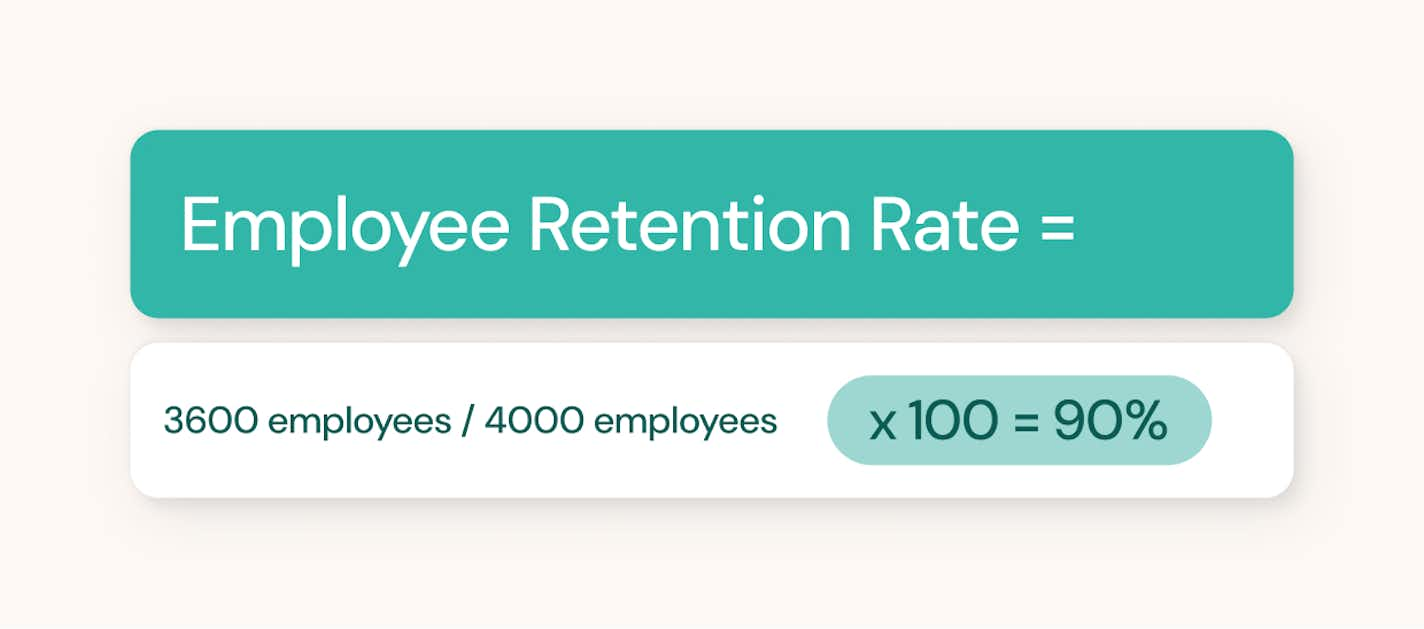A Comprehensive Guide to Employee Retention Analysis

Products used
Employee retention is the cornerstone of most talent strategies, and is critical for organizational stability and growth. It is also central to being able to meet corporate objectives and manage costs. It’s important to understand how to track this important metric, and to ensure you have a strategy in place to support your retention targets.
Understanding the importance of employee retention
Employee retention serves as a linchpin for the longevity and prosperity of any business. Maintaining a stable workforce directly contributes to operational continuity, productivity, and profitability. As HRBPs, we need to make sure that our organization is aware of how it is performing against this benchmark, and that management is aligned on a strategy to ensure successful retention policies and practices.
Why employee retention is crucial for business success
Here are key reasons why employee retention is paramount for business success:
1. Consistency and continuity: Retaining skilled and experienced employees fosters consistency in operations, ensuring that organizational knowledge and expertise remain within the company. This continuity minimizes disruptions and facilitates smoother transitions during periods of change or growth.
2. Cost efficiency: High turnover rates can incur substantial costs for recruitment, training, and onboarding of new employees. By retaining talent, organizations mitigate these expenses and allocate resources more efficiently toward strategic initiatives and development.
3. Enhanced productivity: Employees who remain with a company long-term tend to be more proficient in their roles, resulting in higher productivity levels. Reduced turnover means less time spent on recruitment and training, allowing employees to focus on their core responsibilities and contribute to overall organizational objectives.
4. Improved employee morale and engagement: A stable workforce cultivates a positive work environment characterized by trust, camaraderie, and mutual respect. Engaged employees are more likely to invest their energy and creativity into their work, driving innovation and fostering a culture of excellence.
The impact of retention on organizational culture and performance
Employee retention exerts a profound influence on organizational culture and performance, shaping the workplace environment and influencing outcomes across various metrics. Here's how retention impacts organizational dynamics:
1. Cultural cohesion: A consistent workforce fosters a sense of belonging and cohesion within the organization, leading to a strong and unified company culture. Employees who share common values and goals are more likely to collaborate effectively and support one another, strengthening the fabric of the organization.
2. Attraction of top talent: A reputation for employee retention serves as a magnet for top talent in the job market. Companies known for valuing and investing in their employees are more likely to attract skilled professionals seeking long-term career opportunities and job security.
3. Customer satisfaction and loyalty: Employee retention directly correlates with customer satisfaction and loyalty. Satisfied and engaged employees deliver superior customer service, resulting in positive experiences for clients and enhanced brand reputation.
Employee retention is not merely a human resources metric but a strategic imperative essential for business sustainability and growth. By understanding the importance of retention and its impact on organizational success, companies can proactively invest in initiatives to nurture and retain their most valuable asset—their talented workforce.
Key metrics for effective employee retention analysis
Employee retention analysis relies on a comprehensive set of metrics to gauge various aspects of workforce stability and engagement. By measuring these key indicators, organizations can identify areas for improvement and develop targeted strategies to enhance retention efforts. Below are some of the essential metrics for effective employee retention analysis, with their significance in shaping retention strategies.
Measuring overall employee retention rates
Measuring overall employee retention rates provides a broad view of workforce stability within an organization. This metric typically calculates the percentage of employees who remain with the company over a specified period, such as annually or quarterly. A high retention rate suggests that employees are satisfied and engaged, while a low retention rate may signal underlying issues requiring attention.
Here's the formula for calculating employee retention rate:
Employee Retention Rate (%) = (Number of Employees at End of Period / Number of Employees at Beginning of Period) x 100

Number of Employees at End of Period: This refers to the total number of employees still employed at the company at the end of the timeframe you're measuring (e.g., month, quarter, year). Don't include new hires during this period.
Number of Employees at Beginning of Period: This refers to the total number of employees employed at the company at the beginning of the timeframe you're measuring.
Example:
If you started a month with 4000 employees and ended the month with 3600 employees (not including new hires), your employee retention rate for that month would be:
Employee Retention Rate = (3600 employees / 4000 employees) x 100 = 90%

This means that you retained 90% of your employees from the beginning to the end of the month.
Analyzing retention by demographics and roles
Analyzing retention rates by demographics and roles allows organizations to identify trends and disparities across different employee groups. By segmenting retention data based on factors such as age, gender, department, or job level, companies can pinpoint areas of concern and tailor retention strategies to address specific needs and preferences within each demographic segment.
Evaluating employee satisfaction and engagement levels
Employee satisfaction and engagement are integral components of retention analysis, as they directly impact employees' willingness to stay with the organization. Surveys, feedback mechanisms, and performance evaluations can provide insights into employees' overall satisfaction levels, job perceptions, and commitment to the company's mission and values.
Assessing new hire retention and onboarding effectiveness
Assessing new hire retention rates and onboarding effectiveness helps organizations evaluate the success of their recruitment and assimilation processes. High turnover among new hires may indicate issues with the onboarding experience or alignment between candidate expectations and organizational culture. Analyzing retention data for new employees enables companies to refine their onboarding strategies and improve early-stage retention.
Tracking employee tenure and career progression
Tracking employee tenure and career progression allows organizations to monitor employees' growth and development within the company. Longevity in tenure and opportunities for advancement contribute to employee satisfaction and retention. By identifying patterns in career progression and tenure, organizations can design career development initiatives and succession plans to retain top talent.
Understanding turnover rates: voluntary vs involuntary
Understanding turnover rates requires distinguishing between voluntary departures (resignations) and involuntary departures (terminations or layoffs). Analyzing the reasons behind employee exits enables organizations to address underlying issues contributing to turnover, whether related to job dissatisfaction, organizational culture, or performance issues. Strategies for reducing both voluntary and involuntary turnover can enhance overall retention efforts.
The financial implications of turnover and retention strategies
The financial implications of turnover underscore the importance of effective retention strategies. Turnover costs encompass recruitment expenses, training investments, productivity losses, and potential impacts on customer satisfaction and revenue. By quantifying the financial impact of turnover, organizations can justify investments in retention initiatives and allocate resources strategically to minimize turnover-related costs.
Monitoring absence and leave patterns
Monitoring absence and leave patterns provides insights into employee well-being, workload management, and potential burnout risks. Excessive absenteeism or patterns of extended leave may indicate dissatisfaction or stress among employees. Addressing underlying causes of absenteeism through supportive policies and wellness programs can contribute to improved retention and employee morale.thhihs section
Setting benchmarks: what constitutes a healthy retention rate?
Employee retention is a critical metric for any organization's success. A stable workforce fosters a culture of knowledge retention, boosts productivity, and minimizes the costs associated with recruitment and onboarding. But how do you know if your company is doing well? Enter retention benchmarks.
Industry benchmarks: a starting point
Industry benchmarks provide context for evaluating retention rates and identifying areas for improvement. Benchmarking against peer organizations or industry averages helps gauge performance relative to competitors and industry norms.
Benchmarks offer a valuable snapshot of average retention rates across different industries. While these averages are helpful, it's important to remember they shouldn't be the sole focus. Here's why:
- Industry variations: Retention rates can differ significantly between industries. A high-tech company might have a lower average retention rate than a government agency due to the nature of the work.
- Company size matters: Smaller companies often experience more fluctuation in employee numbers compared to larger, established organizations.
- Company goals: Your retention goals should be tailored to your specific strategic objectives. Are you aiming for rapid growth, requiring more hiring, or prioritizing stability within a core team?
After the benchmark: setting targeted goals
While industry benchmarks provide context, your ideal retention rate should be based on your unique company goals and priorities. Here are some steps to consider:
- Analyze your current retention rate: Calculate your employee retention rate for the past year or quarter. This gives you a baseline to build from.
- Identify your strategic objectives: Are you aiming for rapid expansion, focusing on innovation, or prioritizing operational efficiency?
- Consider turnover costs: High turnover can be expensive. Factor in recruitment, onboarding, and lost productivity costs when setting your goals.
- Segment your workforce: Retention needs might vary across different departments or employee demographics. Consider these differences during goal setting.
Setting SMART retention goals
Craft retention goals that are SMART: Specific, Measurable, Achievable, Relevant, and Time-bound.
For example, instead of simply saying "improve retention," consider a goal like "Reduce call center employee turnover by 10% within one year by implementing a new onboarding program and career development opportunities."
By leveraging industry benchmarks as a starting point and tailoring your goals to your specific needs, you can establish a strategic approach to employee retention that fuels your company's success.
The role of benchmarking in retention strategy development
Benchmarking serves as a foundation for developing retention strategies tailored to organizational needs and objectives. By analyzing benchmarking data and identifying performance gaps, organizations can prioritize areas for intervention and design targeted retention initiatives.
Benchmarking plays a crucial role in setting a strong employee retention strategy by providing several key benefits:
- Context and calibration: Industry benchmarks offer a starting point to understand where your company stands in the retention game. You can see how your current retention rate compares to the average in your industry, giving you a sense of your overall performance.
- Identifying strengths and weaknesses: By comparing your retention rates with industry benchmarks and those of similar companies, you can identify areas where you excel and areas needing improvement. For instance, you might have a higher retention rate than the industry average, but lower than your direct competitors. This could indicate a need to analyze their retention strategies.
- Setting targeted goals: Benchmarks provide a reference point for setting realistic and achievable retention goals. While aiming for the industry average might be a good starting point, your specific goals should be based on your company's unique circumstances and strategic objectives.
- Competitive insights: Going beyond industry averages, benchmarking against direct competitors allows you to gauge their retention performance and potentially learn from their best practices. This can inspire you to develop targeted strategies to attract and retain top talent in your competitive landscape.
- Focus on improvement: Knowing where you stand compared to industry norms creates a sense of direction and accountability for improving your retention efforts. Benchmarks can motivate you to continuously refine your strategies and strive for excellence in retaining your valuable employees.
In summary, benchmarking is not about achieving a specific industry average, but rather about using it as a springboard to:
- Understand your current position in the retention landscape.
- Identify areas for improvement based on your unique goals and competitor performance.
- Set targeted and achievable retention goals that align with your company's overall strategy.
- Develop effective retention strategies to keep your top talent engaged and motivated.
Beyond industry averages: refining your retention compass
Industry benchmarks offer a valuable starting point, but for a more precise picture of your company's retention health, consider taking a deeper dive into your competitive landscape. Here are some ways to refine your retention benchmarking strategy:
1. Target similar companies: Look beyond broad industry averages and identify companies similar in size, location, and business model. Resources like industry reports, professional associations, and competitor websites can be starting points for your research.
2. Leverage external resources: Several HR consultancies and research firms publish industry-specific retention data. These reports often segment data by company size, location, and growth stage, offering a more granular perspective on retention benchmarks.
3. Network with your peers: Connect with HR professionals at similar companies through industry conferences or online forums. Sharing best practices and retention strategies can provide valuable insights into competitor performance.
4. Conduct market research: Consider commissioning a targeted study that analyzes retention rates within your specific market segment. This can reveal valuable insights into competitor initiatives and employee trends impacting retention in your immediate environment.
5. Analyze retention by department: Don't stop at the company-wide level. Benchmark your retention rates for specific departments (e.g., sales, engineering) against relevant competitors. This can highlight areas requiring more focus or reveal departmental strengths to be replicated across the organization.
By employing these strategies, you can move beyond generic industry benchmarks and establish a more precise understanding of your company's retention performance compared to your direct competitors and market niche. This refined perspective will enable you to set targeted goals and implement effective strategies to retain your top talent and gain a competitive edge.
Leveraging technology for enhanced retention analysis
In today's digital era, technology plays a pivotal role in facilitating comprehensive employee retention analysis. Organizations can benefit from harnessing technology to optimize their retention strategies and outcomes.
Choosing the right tools for retention tracking and improvement
Selecting the appropriate tools for retention tracking and improvement is essential for effective retention analysis. Here are key considerations when choosing retention technology solutions:
1. Data accessibility and integration: Look for tools that enable seamless integration with existing HR systems and databases to ensure accessibility and accuracy of retention data.
2. Customization and scalability: Opt for solutions that offer customization options to tailor retention metrics and analysis to specific organizational needs. Additionally, consider scalability to accommodate future growth and evolving retention strategies.
3. Analytics capabilities: Prioritize tools equipped with robust analytics capabilities, including predictive modeling and trend analysis, to uncover insights and opportunities for improvement.
4. User experience: Choose intuitive platforms with user-friendly interfaces that empower HR teams to easily navigate and interpret retention data without extensive training or technical expertise.
Integrating HR software for comprehensive analysis
Integrating HR software systems enhances the efficiency and accuracy of retention analysis by centralizing data and streamlining processes. By integrating various HR functions such as performance management, compensation, and learning and development, organizations gain a holistic view of employee engagement and retention drivers.
The benefits of using advanced analytics in retention strategies
Advanced analytics techniques, such as machine learning and predictive analytics, offer unprecedented insights into employee behavior and retention patterns. By leveraging advanced analytics, organizations can:
1. Identify at-risk employees: Predictive modeling can identify employees at risk of turnover based on historical data and behavioral indicators, allowing proactive intervention to mitigate attrition.
2. Personalize retention strategies: Advanced analytics enable the customization of retention strategies based on individual employee preferences, career aspirations, and performance metrics, leading to higher engagement and satisfaction levels.
3. Optimize resource allocation: By accurately predicting turnover and retention trends, organizations can allocate resources more effectively, focusing on high-impact initiatives that yield the greatest return on investment.
Best practices for improving employee retention
Implementing retention best practices is essential for improving employee retention and cultivating a loyal and engaged workforce.
Developing a positive work environment and culture
A positive work environment characterized by transparency, trust, and open communication is essential for employee satisfaction and retention. Organizations can foster a supportive culture by:
- Encouraging collaboration and teamwork.
- Recognizing and celebrating employee achievements.
- Providing opportunities for feedback and employee voice.
Strategies for enhancing employee engagement and satisfaction
Employee engagement is closely linked to retention, as engaged employees are more likely to remain loyal to their organization. Strategies for enhancing engagement include:
- Providing regular feedback and recognition.
- Promoting work-life balance and flexibility.
- Rewarding employees with meaningful and tailored compensation.
Importance of career development opportunities for retention
Investing in employee development and career advancement opportunities demonstrates a commitment to employees' long-term success and growth. Organizations can retain top talent by:
- Offering training programs and mentorship opportunities.
- Providing clear pathways for career progression and advancement.
- Aligning individual goals with organizational objectives.
The role of pay equity in employee retention
Ensuring pay equity is not only a matter of fairness and compliance but also a critical factor in employee retention. Pay equity analysis and remediation can help to prevent and mitigate retention issues.
Numerous studies have explored the impact of pay disparities on employee attitudes, behaviors, and retention. Here are some key points often highlighted in research:
1. Perceived Fairness: Employees' perception of fairness in compensation is crucial for their job satisfaction and commitment to the organization. When employees perceive pay gaps based on factors such as gender, race, or tenure as unfair, it can negatively affect their morale and motivation, increasing the likelihood of turnover.
2. Equity Theory: Equity theory suggests that individuals compare their inputs (e.g., skills, experience, effort) and outcomes (e.g., compensation, benefits) to those of others in similar positions. When employees perceive inequity in their pay compared to their peers, they may become dissatisfied and more inclined to seek employment elsewhere.
3. Retention Risk: Research indicates that employees who perceive themselves as underpaid relative to their peers are more likely to actively search for new job opportunities. High turnover rates among employees who feel unfairly compensated can result in talent loss, increased recruitment costs, and disruptions to organizational effectiveness.
While specific studies may vary in their methodologies and findings, the general consensus is that pay gaps within organizations can indeed contribute to retention issues. Employers should strive to conduct regular pay equity analyses, address any disparities promptly, and foster a culture of fairness and transparency to mitigate retention risks.
Importance of pay equity in retention
Pay equity, which refers to ensuring fairness and equality in compensation for employees performing similar roles, is essential for maintaining employee satisfaction, engagement, and retention. Disparities in pay based on gender, race, or other factors can erode trust, morale, and loyalty, leading to increased turnover rates.
Predictive role of pay gap in retention issues
Research has shown that significant pay gaps within organizations can indeed be predictive of retention issues. Employees who perceive unfairness or inequality in compensation are more likely to seek opportunities elsewhere, resulting in turnover and talent loss. Addressing pay gaps proactively can help prevent attrition and foster a culture of fairness and inclusivity.
beqom’s Leveling the Paying Field report revealed that pay equity and transparency are increasingly becoming reasons to search for a new job. Nearly half (45%) of US employees said they would seek a job at a company that disclosed a lower gender pay gap than their current employer, a slightly higher rate than UK workers (37%).
Proactive pay equity analysis as a retention strategy
Conducting regular pay equity analysis and implementing remediation measures can be a proactive step in preventing attrition and enhancing employee retention. By identifying and rectifying pay disparities early on, organizations demonstrate their commitment to fairness and equity, thereby fostering employee trust and loyalty.
Metrics for pay equity analysis
When conducting pay equity analysis, several key metrics are essential to consider:
1. Gender/race pay gap: Calculating the difference in median pay between different gender or racial groups within the organization.
2. Pay ratio: Comparing the compensation of executives or top earners to that of average or entry-level employees to ensure fairness in pay distribution.
3. Compensation distribution: Analyzing the distribution of compensation across various job levels or departments to identify disparities.
4. Salary compression: Assessing whether there are significant overlaps in pay between employees with different levels of experience or tenure.
Tools and software for pay equity analysis
Several tools and software solutions are available to facilitate comprehensive pay equity analysis and root cause analysis:
1. Compensation management software: Integrated HR software platforms may include modules specifically designed for limited pay equity analysis. More complete and effective analysis can be done with dedicated pay equity software.
2. Pay equity tools: Dedicated pay equity analytics and remediation tools leverage advanced algorithms and data visualization techniques to identify pay gaps and trends within organizations.
3. Statistical analysis software: In the absence of dedicated pay equity tools, statistical analysis software such as R, Python, or SPSS can be used to perform in-depth statistical analyses and regression modeling to understand the root causes of pay disparities.
4. Data visualization tools: Tools like Tableau or Power BI enable organizations to visualize pay equity data through interactive dashboards and reports, facilitating data-driven decision-making and communication.
In conclusion, pay equity analysis is a crucial component of employee retention strategy, with the potential to preemptively address retention issues and foster a culture of fairness and inclusivity within organizations. By leveraging the right metrics, tools, and software, organizations can proactively identify and rectify pay disparities, thereby enhancing employee satisfaction, engagement, and retention.
The role of compensation in employee retention
Compensation plays a pivotal role in attracting, motivating, and retaining talent within organizations. This section explores the significance of compensation in employee retention, the types of analysis and metrics required to understand its impact, and the capabilities a compensation platform needs to support retention strategies effectively.
Significance of compensation in retention
Competitive and equitable compensation is a fundamental driver of employee satisfaction and engagement. When employees feel fairly compensated for their contributions, they are more likely to remain committed to their organization and less inclined to seek opportunities elsewhere. Compensation not only serves as a reward for performance but also as a means of demonstrating value and appreciation for employees' skills and expertise.
Types of analysis and metrics for understanding compensation's impact
Analyzing compensation data and metrics is essential for understanding its impact on employee retention. Key analysis and metrics include:
1. Compensation benchmarking: Comparing the organization's compensation levels to industry standards and competitors' offerings to ensure competitiveness and attractiveness in the talent market.
2. Pay equity analysis: Assessing the fairness and equity of compensation across different demographic groups (e.g., gender, race) to identify and rectify disparities that may contribute to retention issues.
3. Total rewards analysis: Examining the holistic value of compensation packages, including base salary, bonuses, benefits, and perks, to understand their overall impact on employee satisfaction and retention.
4. Turnover analysis by compensation levels: Analyzing turnover rates among employees at different compensation levels to identify patterns and potential retention risks associated with under-compensation or over-compensation.
5. Retention cost analysis: Estimating the costs associated with turnover, including recruitment, training, and lost productivity expenses, to quantify the financial implications of retention issues and justify investments in retention strategies.
Capabilities of a compensation platform for retention
A comprehensive compensation platform should offer the following capabilities to help organizations analyze, understand, and address retention effectively:
1. Data integration: Seamless integration with HRIS and other systems to access and analyze compensation data alongside other relevant HR metrics, such as performance, tenure, and turnover.
2. Benchmarking tools: Built-in benchmarking capabilities to compare compensation levels against industry standards and competitors, providing insights into areas where adjustments may be needed to improve retention.
3. Pay equity analysis features: Advanced analytics tools and algorithms to conduct pay equity analyses, identify potential disparities, and support remediation efforts to ensure fairness and equity in compensation practices.
4. Total rewards modeling: Functionality for modeling and simulating total rewards packages to assess their attractiveness and alignment with employee preferences and retention goals.
5. Retention risk prediction: Predictive analytics capabilities to forecast retention risks based on compensation data and identify employees at higher risk of turnover, enabling proactive interventions and targeted retention strategies.
6. Custom reporting and dashboards: Flexible reporting and dashboard features to visualize and analyze compensation data, metrics, and trends relevant to retention, facilitating data-driven decision-making and communication with stakeholders.
By leveraging a robust compensation platform with these capabilities, organizations can gain deeper insights into the relationship between compensation and retention, identify retention risks proactively, and implement targeted strategies to enhance employee satisfaction and loyalty.
FAQs on employee retention metrics and analysis
Here are some frequently asked questions (FAQs) related to employee retention metrics and analysis:
Q: What are the key metrics used to measure employee retention?
A: Key metrics for measuring employee retention include turnover rate, retention rate, average tenure, new hire retention rate, and voluntary vs. involuntary turnover rates. These metrics provide insights into the stability of the workforce and the effectiveness of retention strategies.
Q: How can I calculate turnover rate?
A: Turnover rate is calculated by dividing the number of employees who leave the organization during a specific period by the average number of employees during the same period, then multiplying by 100 to express it as a percentage. The formula is: (Number of employees who left / Average number of employees) x 100.
Q: What is considered a healthy retention rate?
A: While retention rates can vary by industry and organizational context, a retention rate above 80% is generally considered healthy. However, it's essential to benchmark against industry standards and continuously strive for improvement based on organizational goals and objectives.
Q: How can I analyze retention by demographics and roles?
A: Analyzing retention by demographics (such as age, gender, ethnicity) and roles (such as department, job level) allows organizations to identify patterns and disparities in turnover rates. This analysis helps tailor retention strategies to address specific needs and challenges within different employee groups.
Q: What role does technology play in retention analysis?
A: Technology plays a crucial role in retention analysis by facilitating data collection, analysis, and interpretation. HR software solutions offer advanced analytics capabilities, predictive modeling, and integration with other HR systems, enabling organizations to identify retention trends and implement targeted interventions.
Q: How can I improve employee retention in my organization?
A: Improving employee retention involves implementing a combination of strategic initiatives aimed at enhancing workplace culture, providing career development opportunities, offering competitive compensation and benefits, and fostering employee engagement and satisfaction.
Q: What are the financial implications of turnover and retention strategies?
A: Turnover can incur significant direct and indirect costs for organizations, including recruitment expenses, lost productivity, training costs, and decreased morale. Implementing effective retention strategies not only reduces turnover costs but also enhances employee productivity, customer satisfaction, and overall organizational performance.
Q: How can I benchmark my organization's retention performance against industry standards?
A: Benchmarking involves comparing your organization's retention metrics against industry averages or best practices. This helps identify areas of strength and opportunities for improvement. Industry reports, surveys, and networking with peers can provide valuable insights for benchmarking purposes.
Q: What are some best practices for using retention analysis to inform HR decisions?
A: Best practices for using retention analysis include regularly tracking and monitoring retention metrics, conducting exit interviews to gather feedback from departing employees, involving key stakeholders in data interpretation, and continuously evaluating and adjusting retention strategies based on insights gained from analysis.
Q: How can I ensure data privacy and confidentiality when conducting retention analysis?
A: It's essential to adhere to data privacy regulations and guidelines when conducting retention analysis. This includes anonymizing sensitive employee data, restricting access to authorized personnel only, and implementing robust data security measures to safeguard confidentiality.
For more information on how to use technology to manage your retention strategy, contact the experts at beqom.















